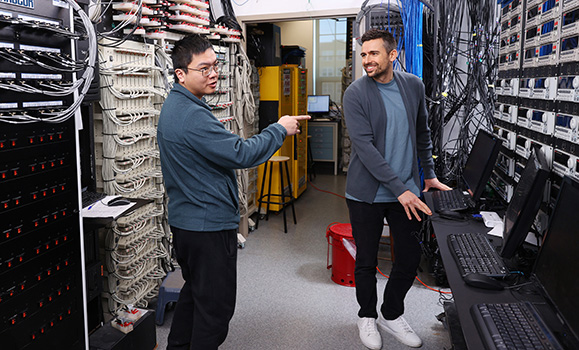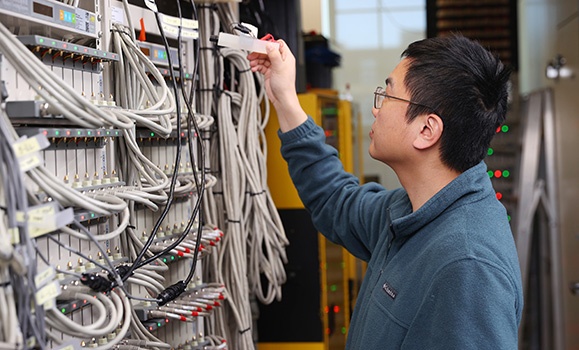Canadian battery science is about to get a turbocharge with the creation of the country’s first university-based battery prototyping and testing facility. Called the Canadian Battery Innovation Centre, the new leading-edge lab is projected to open in Fall 2025 in Dalhousie’s Sir James Dunn Building.
The facility will be a game-changer for the university’s battery researchers, allowing them to rapidly envision, produce and test new batteries. It will also be a magnet for industry in urgent need of the sophisticated equipment and the expertise to operate it.
Currently, battery scientists in academia and startups are required to send designs for new batteries they want to study to third parties outside Canada for manufacture. Drs. Michael Metzger and Chongyin Yang, the Dalhousie battery researchers championing the innovation centre, say it will vastly accelerate the speed of experimentation and innovation — turning a process that currently takes months into days.

Drs. Yang and Metzger.
Construction has yet to start on the $20-million facility, but with a $5-milliion grant from the Canada Foundation for Innovation, $350,000 from Emera Inc., $200,000 from Tesla, and additional matching and promised funds, the financial power is in place to jolt the project into gear.
Accelerating innovation
“We will be able to produce 50 to 100 battery cell prototypes a week at the centre,” says Dr. Metzger, Dalhousie’s Herzberg-Dahn Chair in Advanced Battery Research. “Our focus is on high quality and flexibility, so that we can test many different battery chemistries and materials combinations.”
A series of state-of-the-art machines in an ultra-low humidity “dry room” will provide an assembly line for researchers to create battery cells to the highest industrial standards. Comprised of different functional zones, the lab will include large mixers and furnaces to make battery materials, a smaller closed-off room for the dirtier operations like mixing powders, and a main battery assembly room that includes large coating machines where mixtures of battery active materials and other solvents get applied on metal foil that is then rolled up, inserted, filled and sealed into cell casings by a final group of machines.
The centre’s production line will allow researchers to create batteries using a wide range of materials, including the lithium used in conventional rechargeable batteries, as well as sodium, potassium and other more abundant materials that promise to decrease battery cost and increase lifetime, efficiency and sustainability. Dr. Metzger says the researchers will also focus on the development of new methods of production to remove toxic solvents and polymer binders that are in the process of being banned or shelved by the industry.
“This battery innovation centre will put an extremely powerful tool into the hands of our world-renowned battery scientists and bring them together with industry so that innovations can be put into action quickly,” says Dr. Alice Aiken, Dalhousie’s vice-president, research and innovation. “We’re catalyzing a cluster for battery research and development in Nova Scotia that promises to be transformative for the science, sector, and regional economy.”
Recommended reading: Federal government invests $34.4M in Dal research to unlock innovation in clean tech, heart health, ocean science and more
An open approach
The only similar battery research facilities in Canada are held by corporations focused on developing proprietary intellectual property. Dalhousie’s battery testing and production line will be the first to provide open access.
For a relatively small fee used to maintain and operate the facility, the innovation centre will be available to researchers across Canada and around the world. It will also be a magnet for businesses large and small, who the researchers predict will be attracted to Dalhousie and Nova Scotia as a hub for battery research and development.
It's a safe bet, given that an equivalent centre at the University of Michigan — one of just two in the United States — operates around the clock, with industry partners squeezing in time whenever possible. “Basically, they put up a new schedule for the next quarter on their website and the next day it’s fully booked” says Dr. Metzger.
University of Michigan’s battery lab provides a preview of what can be expected in the Canadian Battery Innovation Centre.
Dan Muldoon, executive vice-president, project development and operations support at Emera Inc. says the new facility will be a benefit for its own work in exploring new energy solutions with Dalhousie’s researchers.
“The CBIC will enable groundbreaking battery research to help accelerate the clean energy transition — right here in Nova Scotia. Emera’s contribution will help leading researchers like Drs. Metzger and Yang to further the overall growth of the industry and in turn, will help advance our own efforts in energy storage innovation,” he says.
A critical link in the supply chain
Ravi Kempaiah, CEO of Dartmouth-based battery startup Zen Energy, says companies like his will be keen to leverage the centre as well. The former Dalhousie postdoctoral fellow who came to Nova Scotia to study with renowned battery scientist Dr. Jeff Dahn says it will allow him to expand his capacity to meet the needs of his company’s investors, like Nigerian utility North South Power, which is working with Zen to help consumers transition away from fossil fuels in emerging markets of Africa.
.jpg.lt_c74501f1af36025a7bac4ecc0aba89f7.res/Ravi1%20(1).jpg)
Ravi Kempaiah, CEO of Dartmouth-based battery startup Zen Energy.
“Having this crown jewel, this battery innovation center for all of Canada, will help us do all our testing right here, so we don’t need to rely on China to build batteries or do advanced testing,” he says. “Startups like us, we can’t spend $2 million or $3 million just to get machines for testing. Having a centralized facility will enable maybe 10 or more startups to share the resources and help train highly skilled professionals. That’s why I think this innovation hub will be incredibly beneficial.”
Dr. Yang says large industrial partners will also benefit from the expertise of Dalhousie’s researchers and the innovation centre’s dedicated battery engineering staff.
“It's not going to be limited to local companies,” says Dr. Yang, who is Dalhousie’s Tesla Canada Chair. “For example, enterprises working in the critical minerals space will be able to send their products to us so that we can test and help develop them, giving us the chance to play a critical role in the whole industry supply chain.”
Dr. Chris Burns, CEO of NOVONIX, a company founded on Dalhousie research that is now a leading domestic supplier of battery-grade synthetic graphite in North America, says the centre will help secure Nova Scotia’s role in Canada’s battery sector.
“This innovation centre provides a unique opportunity for Halifax to continue to build its ecosystem around batteries and energy storage, which will be a significant economic opportunity as we look to develop and attract technology and new businesses," says the industry leader, whose company maintains research and development operations in the province in addition to its large-scale manufacturing centre in Tennessee.
Powering the sector with talent
Dr. Burns also notes that the innovation centre will play a critical role in training the specialized workforce needed for his and other companies in Canada’s fast-growing battery sector. Much-heralded recent investments in Canadian battery manufacturing have been announced by multinationals like Ford, Stellantis, Volkswagen, LG Energy Solutions and Umicore. And in February 2024, Canada topped BloombergNEF’s annual Global Lithium-Ion Battery Supply Chain Ranking, surpassing China for the first time.
It’s a moment for both celebration and concern, says Dr. Metzger. The ranking is based on the abundance of Canada’s raw material resources, strong integration with the American automotive sector, and clear policy commitments. All great news, but Dr. Metzger cautions that the promise of these strengths can only be lived up to if people with skills in battery science are in place to capitalize on them.
 Dr. Burns (shown right) agrees, saying, “The battery sector is growing exponentially and requires a huge influx of talent over the next five to ten years. It is important to see institutions like Dalhousie recognizing that specific training requirements are needed for the battery industry. It’s crucial to offer a targeted battery training program that is not only about education on the scientific fundamentals but also hands-on experience so that graduates can make an immediate impact to the electrification of society.”
Dr. Burns (shown right) agrees, saying, “The battery sector is growing exponentially and requires a huge influx of talent over the next five to ten years. It is important to see institutions like Dalhousie recognizing that specific training requirements are needed for the battery industry. It’s crucial to offer a targeted battery training program that is not only about education on the scientific fundamentals but also hands-on experience so that graduates can make an immediate impact to the electrification of society.”
To that end, Drs. Metzger and Yang say graduate students will play a central role in the operation of the centre, working with faculty to build and test new prototypes. They also envision students working closely with industry partners through internships to help them meet battery innovation goals.
They have developed a new course-based Masters of Battery Technology program that promises to be a pipeline of highly trained battery specialists ready to take positions in the industry. The program has received Dalhousie Senate approval and will be ready for implementation when the innovation centre opens. The researchers are now looking for industry partners that are keen to sponsor the program and hire its graduates.
The last piece in the puzzle
Between opportunities to work closely with Dalhousie’s battery researchers and students and access to leading-edge equipment, Kempaiah says the Canadian Battery Innovation Centre is positioned to become a landmark on Canada’s battery landscape.
“We have something very unique coming together in Nova Scotia for cleantech,” says Kempaiah. “This battery innovation centre is the final piece in the puzzle that is going to allow us to create a cluster around battery innovation — to retain the talent and grow the IP here. It will be a huge anchor point that will bring everything together.”

